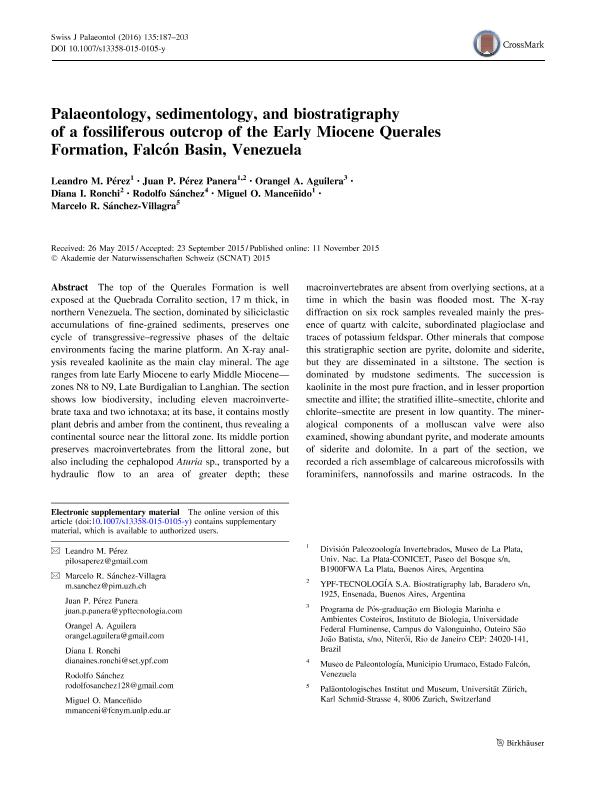Artículo
Palaeontology, sedimentology, and biostratigraphy of a fossiliferous outcrop of the Early Miocene Querales Formation, Falcón Basin, Venezuela
Pérez, Leandro Martín ; Perez Panera, Juan Pablo
; Perez Panera, Juan Pablo ; Aguilera, Orangel A.; Ronchi, Diana I.; Sánchez, Rodolfo; Manceñido, Miguel Oscar
; Aguilera, Orangel A.; Ronchi, Diana I.; Sánchez, Rodolfo; Manceñido, Miguel Oscar ; Sánchez Villagra, Marcelo R.
; Sánchez Villagra, Marcelo R.
 ; Perez Panera, Juan Pablo
; Perez Panera, Juan Pablo ; Aguilera, Orangel A.; Ronchi, Diana I.; Sánchez, Rodolfo; Manceñido, Miguel Oscar
; Aguilera, Orangel A.; Ronchi, Diana I.; Sánchez, Rodolfo; Manceñido, Miguel Oscar ; Sánchez Villagra, Marcelo R.
; Sánchez Villagra, Marcelo R.
Fecha de publicación:
09/2016
Editorial:
Springer
Revista:
Swiss Journal of Palaeontology
ISSN:
1664-2376
e-ISSN:
1664-2384
Idioma:
Inglés
Tipo de recurso:
Artículo publicado
Clasificación temática:
Resumen
The top of the Querales Formation is well exposed at the Quebrada Corralito section, 17 m thick, in northern Venezuela. The section, dominated by siliciclastic accumulations of fine-grained sediments, preserves one cycle of transgressive–regressive phases of the deltaic environments facing the marine platform. An X-ray analysis revealed kaolinite as the main clay mineral. The age ranges from late Early Miocene to early Middle Miocene—zones N8 to N9, Late Burdigalian to Langhian. The section shows low biodiversity, including eleven macroinvertebrate taxa and two ichnotaxa; at its base, it contains mostly plant debris and amber from the continent, thus revealing a continental source near the littoral zone. Its middle portion preserves macroinvertebrates from the littoral zone, but also including the cephalopod Aturia sp., transported by a hydraulic flow to an area of greater depth; these macroinvertebrates are absent from overlying sections, at a time in which the basin was flooded most. The X-ray diffraction on six rock samples revealed mainly the presence of quartz with calcite, subordinated plagioclase and traces of potassium feldspar. Other minerals that compose this stratigraphic section are pyrite, dolomite and siderite, but they are disseminated in a siltstone. The section is dominated by mudstone sediments. The succession is kaolinite in the most pure fraction, and in lesser proportion smectite and illite; the stratified illite–smectite, chlorite and chlorite–smectite are present in low quantity. The mineralogical components of a molluscan valve were also examined, showing abundant pyrite, and moderate amounts of siderite and dolomite. In a part of the section, we recorded a rich assemblage of calcareous microfossils with foraminifers, nannofossils and marine ostracods. In the foraminiferal assemblage, 99 % correspond to planktonic forms. Most macroinvertebrates from benthonic assemblages suggest that they may have inhabited a near-shore marine environment, and sporadically experienced storm transport to deeper, shelf waters.
Archivos asociados
Licencia
Identificadores
Colecciones
Articulos(SEDE CENTRAL)
Articulos de SEDE CENTRAL
Articulos de SEDE CENTRAL
Citación
Pérez, Leandro Martín; Perez Panera, Juan Pablo; Aguilera, Orangel A.; Ronchi, Diana I.; Sánchez, Rodolfo; et al.; Palaeontology, sedimentology, and biostratigraphy of a fossiliferous outcrop of the Early Miocene Querales Formation, Falcón Basin, Venezuela; Springer; Swiss Journal of Palaeontology; 135; 2; 9-2016; 187-203
Compartir
Altmétricas



